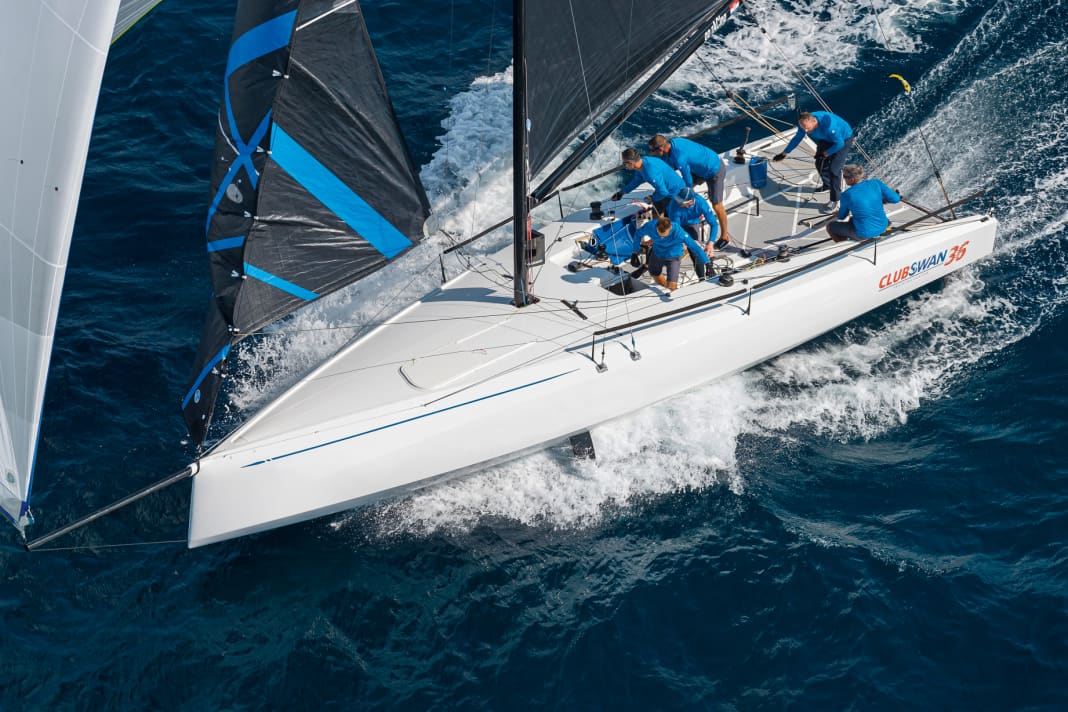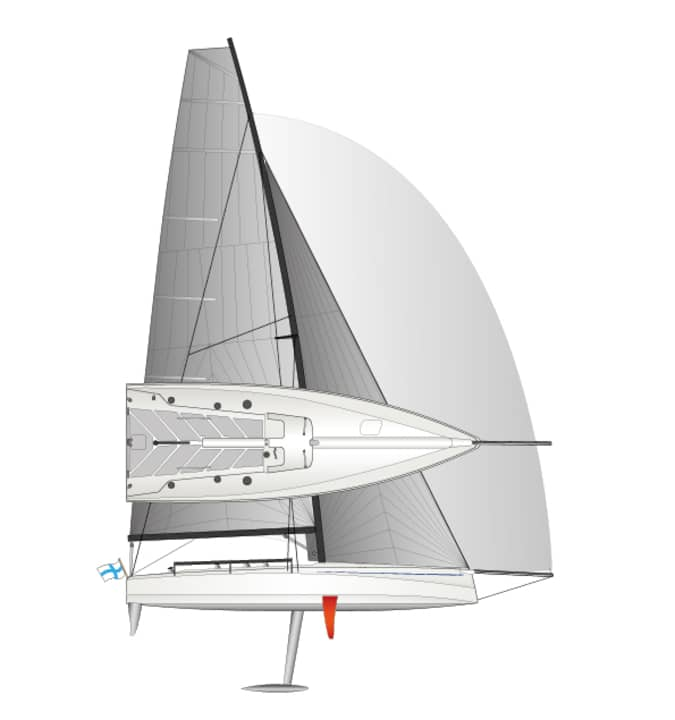





"The trend is moving more and more towards boats that are very fast on the beam and downwind. Because that's the fun part of sailing," says Federico Michetti, who recently took over responsibility for sports activities in the single classes at Nautor's Swan. "However, fast downwind sailing almost always comes at the expense of performance on the upwind course," the Italian continues. The eleven-time world champion in various one-design classes is certain: "The foil will at least partially close this gap."
This foil is the most striking feature of the new ClubSwan 36, but first a brief definition. A foil, or more precisely a hydrofoil, refers to all asymmetrically shaped appendages in the water. This shape allows them to generate lift in a certain direction. The more vertical they are, the more they pull the boat to windward; the more horizontal they are, the more they lift it. The former property reduces drift and therefore ensures a better target speed to windward. Lifting reduces the wetted surface and therefore the boat's form and frictional resistance. With the ClubSwan, however, this has nothing to do with flying, i.e. lifting the hull completely out of the water, for which the term "foiling" is often used.
The C-Foil combines the aforementioned characteristics. On the upwind course, it is fully extended and thus reduces drift. The more heel the boat gets, the more horizontal it is and then lifts the bow; this should be particularly advantageous in heavy seas. It also increases the righting moment of the boat due to the lift downwind. The foil is only deployed about halfway when the boat is under sail and is intended to lift the bow section for faster planing and to help the boat over waves. It is located in a closed box and is moved from one side to the other in just a few seconds using two lines and a winch behind the mast. In any position, it does not protrude sideways beyond the hull and therefore cannot be damaged during harbour manoeuvres.
It is currently difficult to say how much this foil will ultimately achieve. During the test off Barcelona, the boat was able to reach twelve knots with a wind of just under ten knots on the beam and 6.5 knots upwind, but no effect of the foil could be determined. According to Federico Michetti, it is also not yet entirely clear which foil positions are best in which wind depending on the course. In the first comparison races as part of the Nations Trophy revived by Nautor's Swan, four of the first construction numbers sailed against each other. They all sailed in different positions and heeling angles. "It probably takes at least the first season," says Michetti, "to fully understand the boat and sail it at its optimum."
Rig of the ClubSwan 36 flexibly designed
This is because the boat presents future owners with a number of challenges, and not just when it comes to foiling. The design team led by Argentinian Juan Kouyoumdjian, known for his Open 60s and Volvo racers, has created a new standardised class with the aim of establishing a regatta series in the Mediterranean and the Baltic region. The main aim is to have fun sailing, defined as speed as described above. The ClubSwan 36 therefore has nothing to do with the company's performance cruisers, it is a pure racer. It is all about sailing short to medium distance regattas close to the coast. In addition to tactical skill, the trim of the boat will decide who wins and who loses.
This is because the rig is designed to be very flexible. The carbon fibre mast is only supported by a pair of spreaders and can be adjusted lengthways, standing on a semi-circular foot. Instead of a backstay, two backstays are used as trim elements. Due to the strong sweep of the spreaders, the mast remains standing even if the backstays are operated incorrectly. So-called deflectors are attached to the backstays approximately in the centre of the backstays. These run from the backstay almost horizontally to the mast and down through it to the fittings. They can be used to influence the bending curve of the mast.
If the mast trimmer attaches the windward backstay, the sag of the genoa luff is reduced. However, as the backstay is positioned slightly above the forestay fitting, the mast bends at the same time. This may be desirable when the wind increases in order to flatten the profile of the mainsail. However, if this effect is to be avoided, the respective deflector can be used upwind. It pulls the centre of the mast aft against the backstay, thus limiting the mast bend. This trimming instrument will also require some experience in order to be used effectively.
Incidentally, both sails, genoa and main, are fixed with halyard blocks, as is common practice with racers. This reduces the compression pressure in the mast, which can be more delicate. The top weight is also reduced as the halyards can be thinner. In the case of the genoa, this also allows a stretcher to be used to regulate the luff tension in a very controlled manner.
Humpback rudder and twist keel
In addition to the foil, the ClubSwan is equipped with three other remarkable attachments below the waterline. Firstly with a double-bladed system. The rudder blades are designed as so-called tubercle or humpback rudders, modelled on the pectoral fins of humpback whales. This shape is intended to delay stalling at high speeds and tight radii. They are connected aft under the cockpit floor using rods. These can be used to adjust the angle of attack of the blades in relation to each other depending on the expected weather conditions before take-off.
In addition, the ClubSwan has a keel that is 2.75 metres deep and, at 1,163 kilograms, very heavy in relation to its total weight - in other words, it has plenty of counter-torque to the enormous sail area. As a result, it was able to cope with heavy heeling effortlessly during the test and remained absolutely controllable thanks to the double-blade system. The keel bulb is not centred on the keel shaft, but protrudes significantly aft. This is intended to achieve an effect that is usually avoided by designers. When the boat heels strongly in the wind, the asymmetrical weight distribution on the shaft causes the keel fin to twist. The aft part of the bomb hangs slightly to leeward, so to speak, while the lower keel area turns with the leading edge to windward. This gives part of the fin an angle of attack to the direction of travel and should generate more lift to windward.
The ClubSwan is operated using the usual trim devices. These include seven winches, two each for the backstays and for the mainsheet on the side decks, two for the genoa sheets next to the mast and one for the foil adjustment as well as the other trimming devices. As on a large dinghy, these are double on each side so that the boat can be operated completely from windward. All trim lines run on deck without openings to ensure that the boat is as leak-proof as possible. This also increases ease of maintenance. The cover behind the mast is also very easy to remove.
ClubSwan with minimal drive
A very light Nanni diesel engine with just 14 hp is at work below deck; an electric drive can be ordered as an alternative. Similar to the new Dehler 30 One Design, the drive train is completely retractable. With the diesel, however, the boat still managed six knots at full speed in calm conditions. In view of the intended use, pure regattas, the engine is only designed as a manoeuvring aid or lull pusher.
14 boats should be operational for the 2020 season. The class rules have not yet been finalised. It is likely that the crew weight will be limited to 550 kilograms, which would allow up to seven sailors. The owner must also steer. One of Federico Michetti's ideas is also that one crew member should be younger than 25 and that there should also be a woman on board. Only three professionals should be authorised.
With the ClubSwan 36, the Finnish shipyard has created a real fun boat, more of a large dinghy than a fat ship. However, the price - over 500,000 euros for an almost bare epoxy fibreglass hull with some carbon reinforcements - is a bit of a pain. In return, however, it offers all-round service with transport and rigging at the regatta venues as well as the expected high-calibre, technically and tactically challenging regatta sport with growing fields.
Technical data
- Design engineer: Juan Kouyoumdjian
- Torso length: 11,00 m
- Width: 3,60 m
- Depth:2,75 m
- Weight: 2,59 t
- Ballast/proportion: 1,16 t/37 %
- Mainsail: 59,0 m²
- Genoa: 34,5 m²
- Gennaker: 134,0 m2
- Machine: 10.3 kW/14 hp
- Hull and deck construction: GRP epoxy sandwich with carbon fibre reinforcements in the keel area and on the longitudinal stiffeners

Price and shipyard
- Base price ex shipyard: 470.050 €
- Price ready to sail: approx. 517,000€
- Shipyard: Nautor's Swan ( www.nautorswan.com ), built in Cartagena by Sinergia Racing Group

